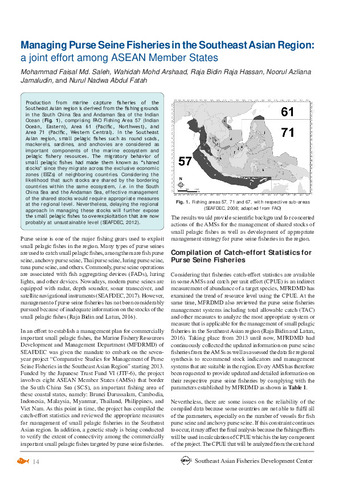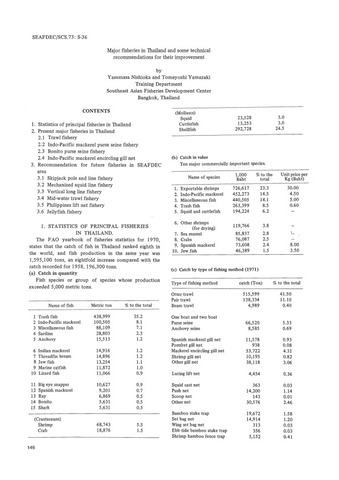Managing purse seine fisheries in the Southeast Asian region: A joint effort among ASEAN member states
Share
Abstract
Production from marine capture fisheries of the Southeast Asian region is derived from the fishing grounds in the South China Sea and Andaman Sea of the Indian Ocean (Fig. 1), comprising FAO Fishing Area 57 (Indian Ocean, Eastern), Area 61 (Pacific, Northwest), and Area 71 (Pacific, Western Central). In the Southeast Asian region, small pelagic fishes such as round scads, mackerels, sardines, and anchovies are considered as important components of the marine ecosystem and pelagic fishery resources. The migratory behavior of small pelagic fishes had made them known as “shared stocks” since they migrate across the exclusive economic zones (EEZs) of neighboring countries. Considering the likelihood that such stocks are shared by the bordering countries within the same ecosystem, i.e. in the South China Sea and the Andaman Sea, effective management of the shared stocks would require appropriate measures at the regional level. Nevertheless, delaying the regional approach in managing these stocks will further expose the small pelagic fishes to overexploitation that are now probably at unsustainable level (SEAFDEC, 2012).
Suggested Citation
Saleh, M. F. M., Arshaad, W. M., Hassan, R. B. R., Jamaludin, N. A., & Fatah, N. N. A. (2017). Managing purse seine fisheries in the Southeast Asian region: A joint effort among ASEAN member states. Fish for the People , 15(3), 14-16. http://hdl.handle.net/20.500.12066/1286
Subject
Collections
Related items
Showing items related by title, author, creator and subject.
-
The Status of Fisheries in the Republic of Maldives
Faiz, Mohamed (Training Department, Southeast Asian Fisheries Development Center, 1997)The paper discusses the tuna fisheries in Maldives which dominates its fishing industry. Apart from a very strong domestic market, tuna is also the main export commodity of the country. Moreover, reef fisheries such as, ... -
Major fisheries in Thailand and some technical recommendations for their improvement
Nishioka, Yasumasa; Yamazaki, Tomeyoshi (Japan International Cooperation Agency, 1977)Presented in this paper is the development of fisheries industry in Thailand. The data on the production of the principal fisheries species and major fishing methods are also presented. Also included are the recommendations ... -
Status of Fishing Conditions in Cambodia
Sour, Kim; Vuthy, Ros (Training Department, Southeast Asian Fisheries Development Center, 1997)Fisheries in plays a very important role in Cambodia’s national economic development. Total fish catch production in 1996 was 104 310 tones, about which 60% was contributed by inland capture fisheries, 30% by marine capture ...





